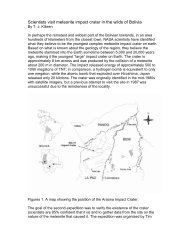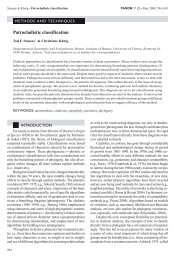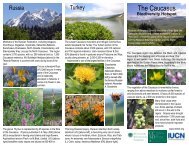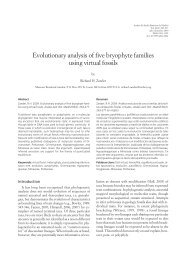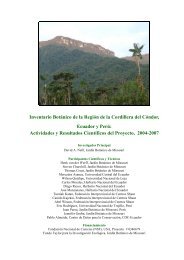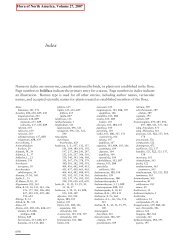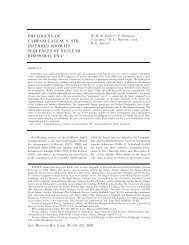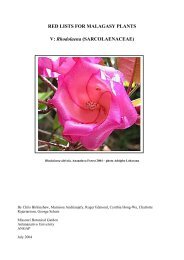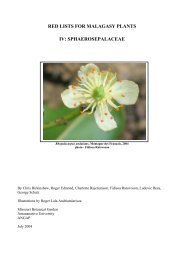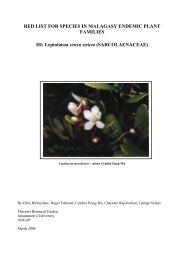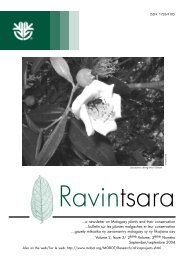...a newsletter on Malagasy plants and their conservation ...bulletin ...
...a newsletter on Malagasy plants and their conservation ...bulletin ...
...a newsletter on Malagasy plants and their conservation ...bulletin ...
Create successful ePaper yourself
Turn your PDF publications into a flip-book with our unique Google optimized e-Paper software.
PRIORITY AREAS FOR PLANT CONSERVATION/AIRES PRIORITAIRES POUR LA<br />
CONSERVATION DES PLANTES<br />
ANALALAVA FOREST : TIME IS RUNNING OUT<br />
Adolphe Lehavana<br />
Last chance to save project<br />
MBG, Madagascar<br />
adolphe.lehavana@mobot-mg.org<br />
The Analalava Forest is<br />
located about 6 km south west<br />
of Foulpointe in the province of<br />
Toamasina. It is <strong>on</strong> laterite <strong>and</strong><br />
would be classified as a low elevati<strong>on</strong> evergreen humid forest<br />
bel<strong>on</strong>ging to the vegetati<strong>on</strong> series of Myristicaceae <strong>and</strong><br />
Anthostema (Humbert & Cours Darne, 1965). As its<br />
<strong>Malagasy</strong> name suggests (ala = forest, lava = l<strong>on</strong>g) it c<strong>on</strong>sists<br />
of a strip of forest about 4 km l<strong>on</strong>g <strong>and</strong> 1.5 km wide. A<br />
2 ha outlier of the forest is found at Mangalimaso, 3 km<br />
west of Foulpointe.<br />
The forest includes a number of restricted area endemics<br />
(species that are more or less c<strong>on</strong>fined to this site) including:<br />
Capurodendr<strong>on</strong> ludiifolium, Chaetocarpus rabaraba,<br />
Cynometra capur<strong>on</strong>ii, Foetidia cuneata, Ixora<br />
quadrilocularis, Malleastrum minutifoliolatum, Mammea castrae,<br />
Milletia hitsika, P<strong>and</strong>anus sylvicola, Rhodolaena<br />
altivola, Tabernaem<strong>on</strong>tana capur<strong>on</strong>ii, <strong>and</strong> Weinmannia<br />
aggregata. Of these perhaps the most special species is<br />
Chaetocarpus rabaraba (local name = rabaraba) in the family<br />
Euphorbiaceae. The genus Chaetocarpus is m<strong>on</strong>ospecific<br />
(i.e. C. rabaraba is the <strong>on</strong>ly species) <strong>and</strong> is <strong>on</strong>ly found in<br />
Madagascar; it is known just from Analalava Forest <strong>and</strong> the<br />
nearby Mahatsara Forest. It is notable for having both male<br />
<strong>and</strong> female trees, <strong>and</strong> for its very strange wrinkled fruits (that<br />
resemble those of litchi).<br />
The fauna of Ananalava forest is not well known but<br />
during our fieldwork at this site we noted an abundance of<br />
birds including Xanthomixis zosterops <strong>and</strong> Terpsiph<strong>on</strong>e mutata<br />
<strong>and</strong> populati<strong>on</strong>s of the diurnal lemurs Hapalemur griseus<br />
<strong>and</strong> Eulemur fulvus. However, lemurs are hunted at the site<br />
<strong>and</strong> sometimes kept as pets by local people. We were<br />
offered at pet lemur for 25,000 Fmg (5,000 Ariary).<br />
The Analalava Forest is heavily exploited by people<br />
from Foulpointe who remove timber <strong>and</strong> wood for carpentry.<br />
C. rababa <strong>and</strong> M. hitsika are particularly favored because<br />
of <strong>their</strong> good quality wood. The wood of C. rababa is also<br />
exploited to provide torches for night fishing because it<br />
burns easily <strong>and</strong> for a l<strong>on</strong>g time like the wood of pine. Even<br />
small quantities of wood of M. hitsika are traded because it<br />
is supposed to bring good luck (but not for the tree!). In<br />
additi<strong>on</strong> to timber exploitati<strong>on</strong> for which at least 25 trees are<br />
felled each day, the forest is threatened by fire, which<br />
destroys significant areas of the forest each year, <strong>and</strong> charcoal<br />
producti<strong>on</strong>, that not <strong>on</strong>ly causes fires but also uses trees<br />
as raw material.<br />
With every passing day the value of Analalava Forest is<br />
being diminished <strong>and</strong> it would seem that current c<strong>on</strong>servati<strong>on</strong><br />
measures are far from sufficient. This could be the result<br />
of the lack of a competent local Forestry Service, a universal<br />
ignorance of forestry laws, or perhaps simple n<strong>on</strong>chalance.<br />
Although the Fok<strong>on</strong>tany that includes the forest has created a<br />
forest management that aims to c<strong>on</strong>trol exploitati<strong>on</strong> of the<br />
forest in collaborati<strong>on</strong> with the police based in Foulpointe,<br />
14 Ravintsara June/juin 2004<br />
FORÊT D’ANALALAVA, URGENCE DE CONSERVATION<br />
La forêt d’Analalava se situe à envir<strong>on</strong> 6 km au sudouest<br />
de Foulpointe, dans la province de Toamasina. Elle<br />
pourrait être c<strong>on</strong>sidérée comme une forêt de basse altitude<br />
sur sol latéritique, appartenant à la série à Myristicaceae et<br />
Anthostema (Humbert & Cours Darne, 1965). Comme s<strong>on</strong><br />
nom l’indique (ala = forêt ; lava =l<strong>on</strong>g), il s’agit d’une<br />
b<strong>and</strong>e de forêt d’envir<strong>on</strong> 4 km de l<strong>on</strong>g et 1,5 km de large.<br />
Un fragment de la forêt se trouve à Mangalimaso à 3 km à<br />
l’ouest de Foulpointe et a une superficie d’envir<strong>on</strong> 2 ha.<br />
La forêt abrite un certain nombre d’espèces endémiques<br />
locales comme Capurodendr<strong>on</strong> ludiifolium, Chaetocarpus<br />
rabaraba, Cynometra capur<strong>on</strong>ii, Foetidia cuneata, Ixora<br />
quadrilocularis, Malleastrum minutifoliolatum, Mammea castrae,<br />
Milletia hitsika, P<strong>and</strong>anus sylvicola, Rhodolaena<br />
altivola, Tabernaem<strong>on</strong>tana capur<strong>on</strong>ii, et Weinmannia aggregata.<br />
Parmi elles, la plus spectaculaire serait peut-être<br />
Chaetocarpus rabaraba (Euphorbiaceae) c<strong>on</strong>nue localement<br />
sous le nom de rabaraba. Ce genre est m<strong>on</strong>ospécifique,<br />
c’est à dire avec une seule espèce d<strong>on</strong>t C. rabaraba, et il<br />
est endémique de Madagascar et plus précisément de la<br />
forêt d’Analalava et de Mahatsara. Il est remarquable par<br />
sa dioïcité, c’est à dire avec des pieds mâle et femelle distincts,<br />
et également par ses fruits ridés qui ressemblent à<br />
ceux du litchi.<br />
La faune d’Analalava n’est pas bien c<strong>on</strong>nue mais durant<br />
une de nos visites, nous av<strong>on</strong>s pu observer plusieurs espèces<br />
d’oiseaux comprenant Xanthomixis zosterops et Terpsiph<strong>on</strong>e<br />
mutata et des populati<strong>on</strong>s de lémuriens diurnes, Hapalemur<br />
griseus et Eulemur fulvus. Certaines de ces espèces s<strong>on</strong>t<br />
pourtant chassées et commercialisées sur le marché local<br />
comme animaux domestiques. Un lémurien se vend à 25<br />
000 fmg (5000 Ariary).<br />
La forêt d’Analalava est lourdement exploitée pour le<br />
prélèvement des bois de menuiserie. Ainsi, C. rabaraba et<br />
M. hitsika s<strong>on</strong>t particulièrement prisées en rais<strong>on</strong> de la qualité<br />
de leur bois. Rabaraba est aussi exploitée pour fournir<br />
des torches utilisées pendant la pêche nocturne car s<strong>on</strong> bois<br />
brûle facilement et l<strong>on</strong>guement comme celui du pin. Hitsika<br />
est très appréciée pour s<strong>on</strong> bois à usage multiple, mais en<br />
plus un morceau de s<strong>on</strong> bois est localement réputé être un<br />
porte-b<strong>on</strong>heur. C’est pourquoi, cette espèce est actuellement<br />
très recherchée et est même vendue en petite quantité<br />
(quelques kilogrammes). Outre l’exploitati<strong>on</strong> du bois pour<br />
laquelle 25 arbres s<strong>on</strong>t en moyenne abattus chaque jour, la<br />
forêt est menacée par le feu qui détruit d’importantes surfaces<br />
forestières chaque année. En plus de cela, des fours à<br />
charb<strong>on</strong>s s<strong>on</strong>t observés un peu partout dans la forêt, et peuvent<br />
provoquer n<strong>on</strong> seulement ces feux de brousse mais le<br />
charb<strong>on</strong> lui-même est produit à partir d’espèces forestières.<br />
La situati<strong>on</strong> s’aggrave de jour en jour et les mesures de<br />
c<strong>on</strong>servati<strong>on</strong> actuelles s’avèrent insuffisantes. Cette situati<strong>on</strong><br />
pourrait s’expliquer par l’inefficacité et les carences du<br />
Service Forestier local, par l’ignorance des lois forestières et<br />
aussi par simple n<strong>on</strong>chalance. Malgré que les autorités





